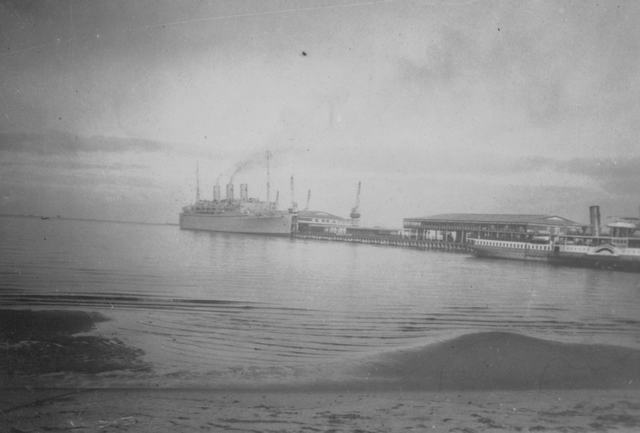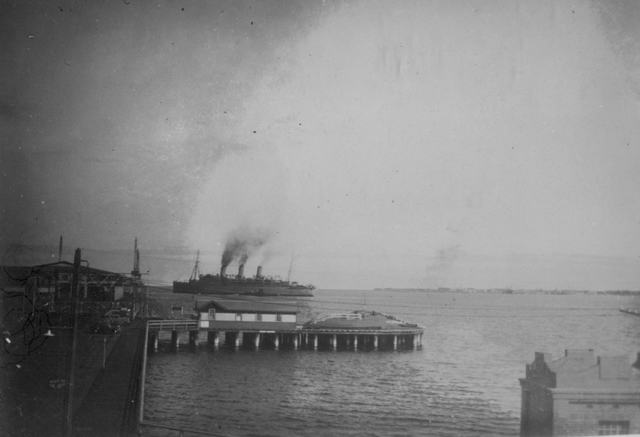

We arrived off Gabo Island where we were to meet the rest of the convoy. We were the largest convoy to leave Australia. There were six more ships - "Queen Mary", "Acquatania", "Mauritania", "Empress of Canada", "Empress of Japan", "Empress of Britain" and the captured German liner "Andes". It was the most glorious sight, because as we approached Gabo Island the convoy came around the island. It was about 7am on a beautiful sunny morning. Like the other ships, the captured german ship had our troops on board. From there we went to Freemantle (Western Australia).
We had four days there and I went to afternoon tea and met the Governor and his wife, alond with about 200 other servicemen.
We were headed for Ceylon (now Sri Lanka) but we didn't get there. A day out of port as dawn arrived we found ourselves heading south-west instead of north-west. This set rumours flying everywhere! It was just at this time that the Germans forces started to invade across Holland and we had been diverted to head for Great Britain via South Africa.
There was great argument as to where we were going at that stage. Some thought we were going to Madagascar, others had other ideas but we finished up in Cape Town (South Africa).
Capetown
We went into the harbour at Cape Town and "Queen Mary" went down to the Naval Base to refuel. We were there for four days.
On the second day there we were given two hours leave - only two hours. We thought this very paltry, so there was a meeting on board - I think you would call it a rebellion and we decided we would walk off the ship the next day. So, at 9am we went down the gangway and formed up on the wharf in three's and the NCO's marched us out of the main gate.
Waiting outside the gate were about 200 cars with ladies driving them and they entertained us for the day. We were taken about 50 miles down the coast and our carload went home with our driver to her home for lunch, went out to a restaurant for tea and were back on board the ship about 8 o'clock. There was a reception committee waiting for us at the top of the gangway. The next morning at 9 o'clock we were paraded five at a time and fined five pounds . It was well worth it though. [Editors note: Ray's Service Record shows an enrty dated 31 May 1940 as "29 May 1940:AWL 10 hrs - Fined 2 pounds - forfeit 1 days pay".]
From Cape Town the Chinese crew refused to go any further as their contract specified that they were not to go into any war zone. As a result, we received 50 sailors from the British cruiser "Sussex". They worked on our ship's engines and we soldiers worked the rest of the ship.
Under Escort to England
On the way to Capetown we had the escort of the heavy cruiser "Australia" and the light crruiser from New Zealand - "Leander". From Capetown the British Navy took over and we had a couple of their cruisers as escort. We went up to Sierra Leone, Freetown is the capital. I would say there were 200 ships in that harbour when we arrived and we had only been there about an hour when a plane came over to have a look at us. I think every ship in the harbour opend up at it. No-one hit it probably because he was up too high. It was quite good entertainment watching this.
We had a man overboard in the Indian Ocean from the ship in front of us - "Empress of Japan". In front of "Empress of Japan" was "Acquitania". It was said that ships never stop in wartime - but they did. They stopped and "Acquitania" went behind us and came up and put down boats to find him, but he wasn't found. "Leander" also came and looked without success.
From then on we had a real escort. We had 25 warships guarding our seven ships. We had the battleships "Hood" and "Ramillies", the aircraft carrier "Argus", four cruisers, ten destroyers, eight mine sweepers and Sunderland flying boats. We were now entering into the submarine infested area of the Atlantic ocean.
The Australian Sunderland flying boats would fly out from England each day to guard us. We went up
the Irish channel which was even worse because it was narrower and the enemy could get at us, but we
didn't get attacked. We continued up to Scotland to a place called Goorak at the mouth of the Clyde river
in Scotland. It was the port for Glasgow.
![]()
 |
 |
 |
|---|